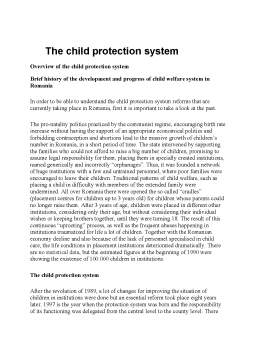Extras din referat
Overview of the child protection system
Brief history of the development and progress of child welfare system in Romania
In order to be able to understand the child protection system reforms that are currently taking place in Romania, first it is important to take a look at the past.
The pro-natality politics practiced by the communist regime, encouraging birth rate increase without having the support of an appropriate economical politics and forbidding contraception and abortions lead to the massive growth of children’s number in Romania, in a short period of time. The state intervened by supporting the families who could not afford to raise a big number of children, promising to assume legal responsibility for them, placing them in specially created institutions, named generically and incorrectly “orphanages”. Thus, it was founded a network of huge institutions with a few and untrained personnel, where poor families were encouraged to leave their children. Traditional patterns of child welfare, such as placing a child in difficulty with members of the extended family were undermined. All over Romania there were opened the so called “cradles” (placement centres for children up to 3 years old) for children whose parents could no longer raise them. After 3 years of age, children were placed in different other institutions, considering only their age, but without considering their individual wishes or keeping brothers together, until they were turning 18. The result of this continuous “uprooting” process, as well as the frequent abuses happening in institutions traumatized for life a lot of children. Together with the Romanian economy decline and also because of the lack of personnel specialised in child care, the life conditions in placement institutions deteriorated dramatically. There are no statistical data, but the estimated figures at the beginning of 1990 were showing the existence of 100.000 children in institutions.
The child protection system
After the revolution of 1989, a lot of changes for improving the situation of children in institutions were done but an essential reform took place eight years later. 1997 is the year when the protection system was born and the responsibility of its functioning was delegated from the central level to the county level. There were opened 41 County Directions for Child Protection and one in each of the 6 sectors of Bucharest with financial and operational responsibilities regarding children in difficulty as well as other protection institution from the counties. The decentralized approach had the objective to prevent the institutionalisation by providing support to the families and closing up the large institutions simultaneously with finding alternative solutions for child protection. A number of elements accelerated the child protection system reform in Romania such as the founding of the Department for Child Protection – central institution with the role of coordination and elaboration of child protection politics and the fact that, in 2000, the Directions of Child Protection took over the institutions sheltering children, subordinated initially to other central institutions.
The National Authority for the Protection of Child Rights (NAPCR) has the responsibility of coordinating the reform process at national level. Te role of NAPCR is to elaborate the child protection politics and to coordinate the programmes financed at national and international level.
Main elements of the child protection system reform:
- In 2001 The Romanian Government adopted “The Government Strategy regarding the protection of children in difficulty 2001 – 2004”. The strategy was proposing the adoption of a series of radical reforms with the purpose of bringing Romania up to the international standards of child welfare and protection, priority number one being the changing of the “institutionalized” system into a “family” system. In this period of time, the reform meant closing large institutions and replacing them with alternative services, prevention of child separation from the family by developing support services and adapting the Romanian child protection system to the European standards by harmonizing the Romanian legislation.
- The Law 272 regarding Child Rights Protection and Promotion enter into force on the 1st of January 2005. The Public Authorities, the civil society and others are now responsible for guaranteeing the children rights as they are stipulated in the United Nations Convention for Child Rights. The present law, with major accent on the best interest of the child mentions for the first time the fact that the parents have the main responsibility in raising and ensuring the development of a child. The subsidiary responsibility falls on the shoulders of the extended family and the local community to which the child belongs, the intervention of the state being complementary. The state has the duty to ensure the child protection and to guarantee the observance of all rights. The state can intervene in cases of abuse or severe deprivation. The law aims to change the idea that the state could replace parental care.
Preview document
Conținut arhivă zip
- fata referat.doc
- The Child Protection System.doc














